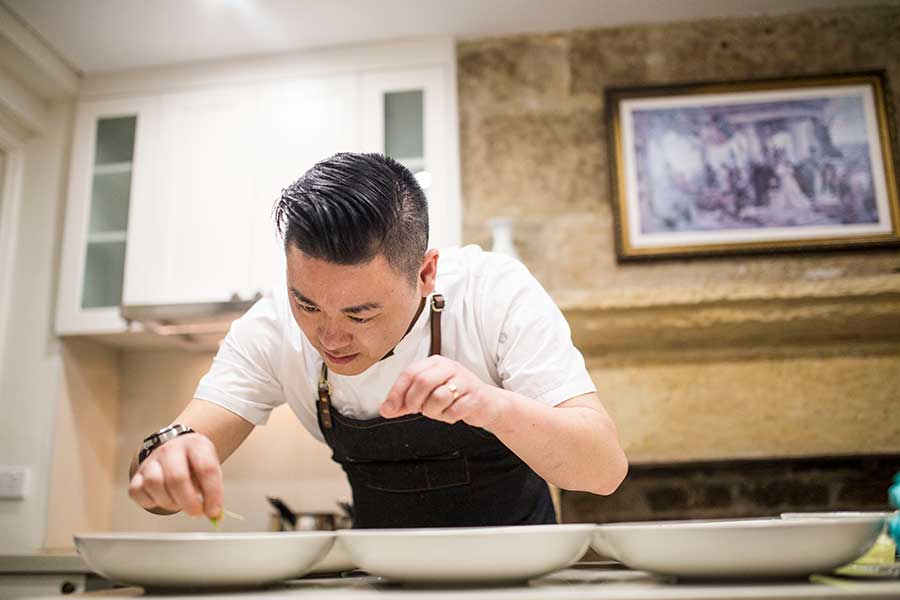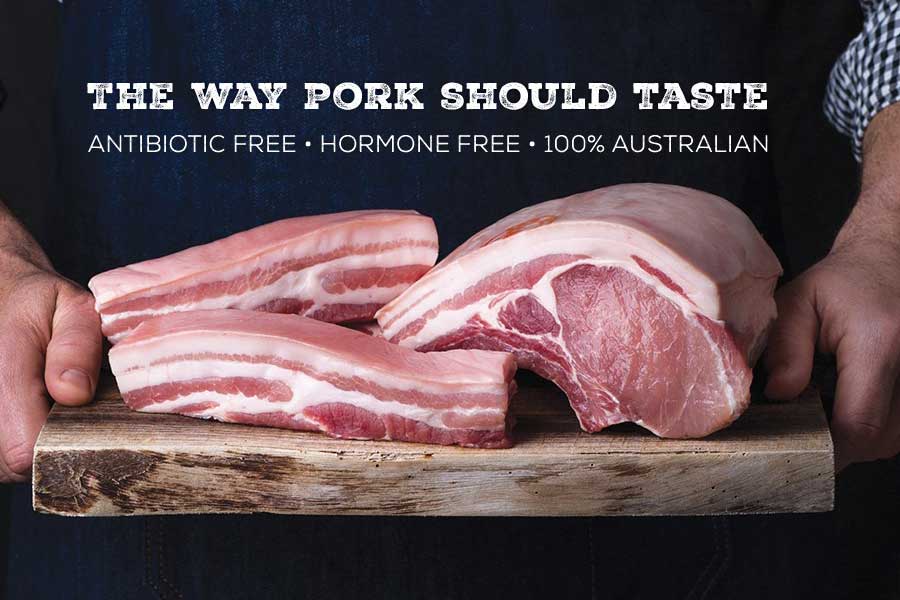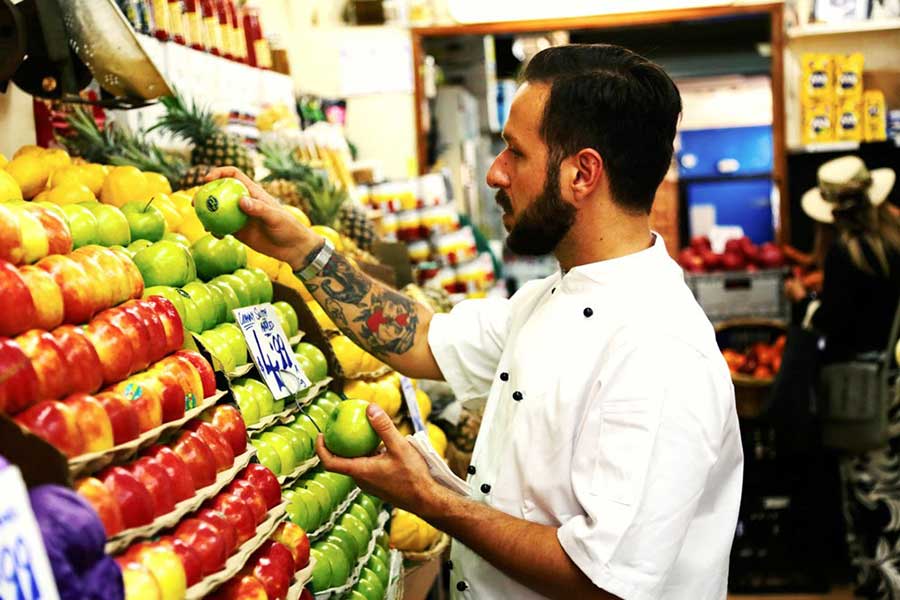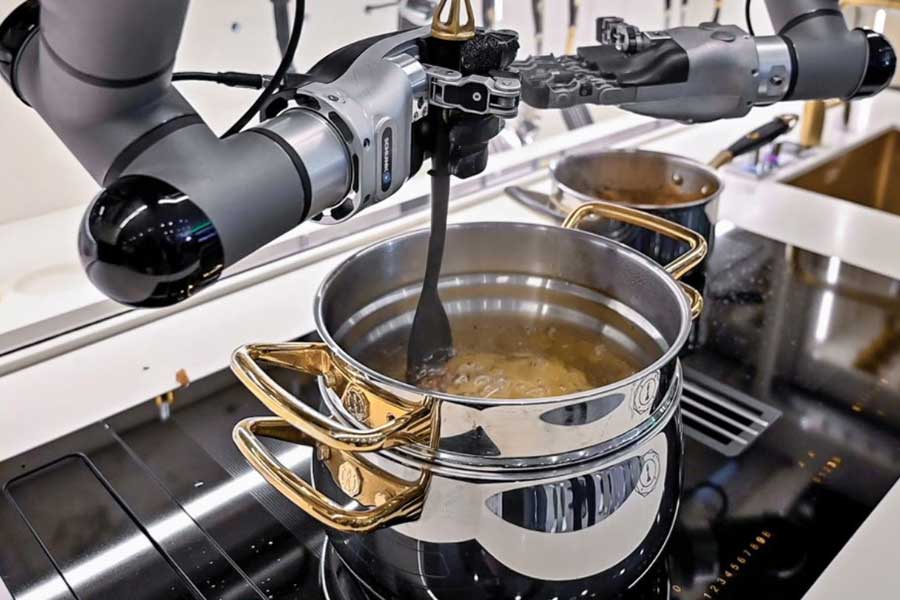There are transformations happening everywhere you look. Almost every industry is shifting into new and uncharted territory thanks to a combination of technological advancements, globalisation, and climate change. Covid-19 has only accelerated these transformations, forcing entire industries to shift and adapt so they can keep up with a rapidly changing world.
Disruptions were rife all across hospitality, with businesses changing to takeaway only, offering new at-home dining packages, and being forced to rethink their business model to make it through to the other side.
The future for hospitality is uncertain, and there’s no telling where things will go from here. In the midst of these turbulent times, there’s a burning question on every chef’s mind – “What is my future going to look like?”
Keep reading as we imagine what the future looks like for chefs…
To give you a little ‘taste’ of the future, you can expect:
Robots in the kitchen
Imagine yourself, in the future, eating at a restaurant and using a bit of bread to mop up the last bits of pasta sauce left on your plate. What you’re eating has to be one of the best spaghetti bolognese you’ve had in your life. Future-you motions to the waiter and asks to speak to the chef so you can thank them personally. You are led to the back of the restaurant and through the swinging doors of the kitchen. But there’s nobody there – except for a large pair of metallic hands hanging from an overhead track. Could it be? Your meal in the future was made entirely by a set of robot hands…?
There’s nothing more futuristic than robots taking over, and now they’ve made their mark on kitchens. You had already seen and heard about robots being used in food service, replacing the need for waiters and waitresses, but you hadn’t expected robots to take on the role of professional chefs!
How robots are taking over kitchens
OK, let’s rewind a little bit back to the present moment. There’s a robotics company called Moley Robotics, run by a computer science engineer called Mark Oleynik. Thanks to years of research, innovation, and hardcore engineering, the Moley Robotics team are the first to develop a robotic kitchen. They have paved the way for the future of cooking by integrating the robot into the kitchen itself, reducing the role of a chef to a strong pair of hands able to carry out a wide range of tasks and operations.
Moley Robotics’ slick robotic chef has automated hands that can cook more than 5,000 different recipes, plate up dishes on its own, and even clean up the mess afterwards. The robot chef’s hands are operated from an overhead track and guided by optical cameras and sensors. It uses its own bespoke pans and utensils and cooks on a touch-based induction cooktop. Recipes are built into the robot kitchen, so you can ask the robot chef to cook what you want at the click of a button. And unlike a professional chef, the robot kitchen can cook anything and everything without the need to undergo years of training and study.
Welcome to the team Mr Robot
With more than 5,000 recipes in its catalogue, Moley Robotics’ robot kitchen is capable of cooking endless dishes and adapting to dining trends. Even the world’s most professional chefs don’t have the skillset to create such a vast range of dishes and recipes. The robot kitchen can make soups of the day, French fries, fried chicken, or teppanyaki. It’s multifunctional and can adapt and learn from new recipes and ingredients. It’s the ideal chef for any household or commercial restaurant operation: precise, quick, creative, and efficient.
You can ask the robot kitchen to perform a wide range of kitchen tasks, like prepping, cooking, plating, and cleaning, or enroll it to take on the role of one or two sous chefs and have it complete specific operations over and over. The robotic hands of Moley’s kitchen can recreate the movements of professional chefs, able to chop, stir, whisk, and fold like a pro. And, all things considered, the investment for the robotic chef is not too hefty. You can get a base Moley kitchen unit with robotic arms for around $335,000.
Are robot kitchens the end of chefs?
So, wait… does a robot kitchen mean you’ll no longer need a human chef? Not really. Despite all their innovation, robot kitchens are yet to replace human chefs. In fact, the chef of the future works with the robots and not against them. Moley’s robot kitchens can follow instructions from a real chef, which makes them an ideal cook. Even with all the technology and memory that’s fed into a machine that can memorise 5,000 recipes, nothing comes quite close to the creativity and artistry of a professional chef. The world’s not looking for robot chefs to cook the same dishes over and over: it still wants to be surprised, amazed, and intrigued by the creations of a human chef.
And despite their incredible capabilities, robotic hands will never match the dexterity of a human professional chef. As human beings, we’ve had a lifetime of training our hands for movement and dexterity. In contrast, the robot chef made by Moley has about 20+ degrees of freedom. Enough to execute a lot of kitchen tasks, but not enough to do the chef’s job better than he does it himself.
So, let’s jump back to the future. Robotic chefs have transformed commercial kitchens in hotel and restaurant chains around the world. If your future self is ordering 24-hour room service in a hotel, you can almost always expect your meal to be created by one of these innovative robot chefs. Human chefs no longer need to work entire night shifts just to serve up one or two dishes to those night owls. In hospitals and retirement homes, robot kitchens have made it easier than ever to access fresh, delicious food. The mundane menus of these institutions have been replaced with the 5,000+ catalogue of inspiring recipes offered by the robot kitchen, bringing tasty food to those who’ve traditionally been served sub-par meals.
How soon will we start seeing robotic kitchens?
Can’t fathom a future where professional chefs are a mere set of robotic hands? You won’t have to look too far ahead to see it become a reality. We’re already seeing a number of robots working commercial kitchens and taking on the roles of line cooks.
In the USA, Miso Robotics have created Flippy. This happy robot is employed at 11 different White Castle burger restaurants, flipping burgers and making fries on repeat. In Tokyo, sushi restaurant Sushiro has employed a team of robots to cook, mold, and season sushi rice with vinegar. They work alongside a team of humans who then complete the sushi by adding hand-cut fish.
Robots taking on the roles of humans doesn’t have to be all doom and gloom. There won’t be any scary metallic Gordon Ramsays to run away from. It’s more likely that the future for chefs will be working alongside robots, allowing them to take on the more mundane, basic, and repetitive functions in the kitchen so humans can focus on what they’re good at and love doing the most.
Food experiences as an artform
In the future – with our robot overlords taking over restaurant and hotel kitchens – it’s no longer a struggle to find great-tasting food. Less and less people are disappointed by a subpar meal as crews of robots learn to perfectly execute numerous recipes and take on those repetitive kitchen tasks once manned by cooks. We’ve all become used to eating delicious food, anytime, and anywhere – but then what happens when you want a super special food experience? It’s simple – a professional chef will be seen as an artist.
The art of dining
In a food industry taken over by mechanical hands and robot kitchens, professional chefs are an asset. The complexity and individual nature of the human mind is prized and cherished. Robots, although highly skilled, are unable to match the uniqueness, innovation, and personality of a chef who is doing what they love. Robot kitchens might be able to churn out dish after dish of beautifully presented, delicious food, but they can’t create intimate food experiences. They can’t fuel connection over the dinner table, inspire new dining trends, or find inspiration in their surrounding environment. And it’s in this realm of intrigue, imagination, and innovation that chefs thrive in the future.

With good food being a norm in the future, fine-dining, special occasions, and celebrations demand a focus on food experiences. Dining trends are about more than just the ingredients used in a dish – they encompass the intimacy and interactivity of the atmosphere and the creativity of the professional chef. Future fine-dining is an immersive food experience where we’re taken out of our everyday realities and plunged into a world created by professional human chefs expressing themselves and their love of food.
We want our food to be human
Chefs of the future have unbridled creativity and the ability to create unparalleled food experiences that are memorable, unique, and captivating. For diners, these food experiences are a welcome change from the somewhat repetitive nature of robot kitchens and delicious but a-little-too-precise meals. Dining trends have a focus on being human, on connection and memory-making. There is artistry, creativity, and innovation. Unique food experiences of the future are fuelled by imagination and humanity that robots just cannot compete with.
There’s no particular way that chefs of the future express their creativity and humanity. Some do it with the intriguing use of ingredients, others with an innovative approach to serving and eating the food. Some chefs design incredible atmospheres in which to dine while others encourage interaction at the dinner table. Whatever it is – every chef is taking full advantage of their creative capacity as artists. They’re no longer confined to the trappings of a restaurant kitchen and are creators in their own right, doing what they love without the pressures and restraints of a set menu.
Ultra-urban farming is well and truly here
In 2022, ultra-urban farming is a dining trend that’s only just starting to creep into mainstream understanding. In the future, ultra-urban farming will be the norm, a phrase that is so commonplace that people don’t remember a time it wasn’t a thing. We’ll be so used to hyper-local produce grown in our urban environments that we’ll take it for granted.
A world where hyper-local produce is the norm
In the future, country farms will still exist, but we will have learned to not be so heavily reliant on the natural cycles and unpredictable weather patterns to get our fresh produce. Innovation in indoor farming has made hydroponics and aquaponics accessible to urban areas across the globe, and people will be enjoying fresh fruits and vegetables that are grown in their local area without having to source produce from abroad. It’s more efficient, more sustainable, and a whole lot better for humans, and the earth in general, from a supply chain perspective.
In the future, the world will no longer be reliant on global supply chains. If another Covid-19 was to hit, we’d be undeterred by shipping crises and food shortages – because every local area will be self-sufficient and have its own urban farms producing fresh fruit and vegetables using high-tech farming practices. There will be farms on rooftops, in disused air-raid shelters, abandoned buildings, and inside supermarkets.

Your future self will be able to pop into your local supermarket and pick mushrooms that were grown above the grocery aisle. The carrots and asparagus in your shopping basket will have been grown in a greenhouse behind your local fruit & veg shop. The salad you’ll buy from your local deli will be made from greens & herbs grown in your hyper-local area with dressing made using local ingredients that were blended together by robots. This is a future where the dining trends of ‘farm to table’ and ‘eat local’ are accessible to everyone, everywhere.
Thanks to ultra-urban farming, in the future we will be able to enhance food security across the world. The world’s growing food demands will be able to be met by scientific advancements in farming that allow for produce to be grown anywhere, without relying on having the right natural environment. Global food production will be sustainable, and we’ll all be able to enjoy food that was grown responsibly, locally, and ethically, without costing us the earth.
Reducetarianism dominates
Professional chefs of the future will be no strangers to dining trends and food fads. They will have seen all kinds of strict diets and fads, hardcore vegans and fruitarians, carnivore loyalists and people passionate about paleo. But at some point in the future, a moderate middle ground will appear – reducetarianism.
Reducetarianism is a dining trend that is born out of a growing desire to help the planet by reducing our intake of meat and dairy products. People aren’t ready to give up their cheese and steaks just yet. But they’re happy to cut down their intake if it means lessening their harmful impact on the earth. To put it simply: reducetarianisms aren’t working towards eliminating or giving up anything. They just want to cut down a little bit to help the earth out where they can. And it’s already made a difference even in the present day! People who reduce their meat consumption by as little as 10% create significant benefits on their health, the environment, and the welfare of farmed animals.
In a future where people are consuming less dairy and meat products than ever before, countries will become more self-sufficient and sustainable. There will be less of a need to import animal products from abroad. Local farmers and producers will be better able to cater to the needs of the local population. Better still, when people do opt to eat animal products, they’ll be making more high quality and ethical choices, reaching for premium grass-fed meats and pasture-raised eggs. It’s a win-win for everyone.

As for future chefs, they’ll be happy to see moderation in dining trends. You can still cook your filet mignon and oeufs cocotte. In fact, your meat and dairy based dishes will be more appreciated than ever, a special moment for diners who no longer take such meals for granted.
Examples of a reducetarianism diet
A reducetarianism diet is all about small, simple steps to reduce your impact on the Earth. There are no drastic measures or unnecessary purchases. You don’t have to overhaul your diet. Here are some examples of a reducetarianism diet that show just how gentle it is to begin implementing:
- Cutting down your meat intake – You can start with ‘Meatless Mondays’ or opt to eat meat every second day of the week instead of everyday. Another way to reduce your meat intake is by buying smaller steaks! It’s that simple!
- Consuming more plant-based proteins – Whether it’s jackfruit chicken or good old-fashioned beans, there are plenty of ways you can get your protein intake in a more sustainable way.
- Eating cultured meat – Also called cell-based meat, this kind of meat is grown in a lab by using stem cells taken from the muscle of an animal. Don’t freak out, it’s all natural and just as nutritious as natural meat! Expect to see cultured meat hitting the supermarket shelves in the next couple of years.
VR and augmented reality heighten food experiences
You’re sitting in a restaurant booth in the future, your mind flicking back to distant memories of the past. Ordering an item from the menu, visualising it in your mind, and ending up with a vastly different, disappointing plate that was not what you imagined. Flicking through menus full of strange dining trends you don’t understand and not having accompanying images to help you make the decision of what to eat. Ahhh… thank god for augmented reality in the restaurant industry!
You come back to the future, seated in your restaurant booth, and flick open the menu. The integrated augmented reality technology allows you to see true-to-scale 3D visual representations of each item on the menu. There’s a hyper-realistic cacio e pepe, a cheeseburger that looks so real you can almost see the sauce dripping onto the table. Choosing the dish you want is easier than ever when you can literally see it right before your eyes.
Augmented reality in the food industry
Using AR technology to visualise food on a menu has been in development for some time. Menu AR, a Russian startup, is already offering diners the chance to see dishes on the menu in 3D while seated at their table. You can visualise the texture, see each and every ingredient, and know how big the portion really is. In New York, a startup called Kabaq is doing the same thing. Only this time, you can even access the visualisation feature from your own home when ordering takeaway. But augmented reality technology in the food industry is offering more than just an early glimpse of what your dish might look like. You can see exactly how ingredients were sourced, as well.
NexTech AR is a company that lets buyers know exactly how their seafood gets from the sea to their plates. They can take a tour of the fishing boats where fishermen are sourcing lobster, experiencing the entire process of sea to table. This helps diners to better appreciate where their food is coming from. It also enhances their connection to the ingredients and stories of the people behind them. It’s not just about sourcing ingredients, either. Whisky aficionados can go on a virtual reality journey where they’ll learn exactly how their whisky was processed, from the barrel to the glass. People have an entirely new relationship with the food they’re eating, no longer strangers to the process or the producers.
You can now eat from anywhere
Remember the artistic dining and food experiences we mentioned before? These are able to be elevated with limitless possibilities through the power of AR and virtual reality. Dining trends will see people eating from literally anywhere, be it a rooftop, outer space, or floating garden. It will be possible to enjoy food experiences in a reality-bending way that we never even imagined. Chefs can curate your food experiences or you can design them yourself. The focus is on limitless possibilities, creativity, and larger-than-life dining.
The future for chefs starts now
While Covid-19 may have changed the face of hospitality, it’s far from being the end for restaurants or chefs. It’s simply a time to adapt, grow, and innovate. The pandemic has forced the food and restaurant industry to start embracing a new way of doing, being, and existing in the modern world. And it’s pushing us into the future faster than ever.

Professional chefs need not worry about their future. In fact, it’s an exciting time to be a part of an industry that’s growing and moving forward quickly. So, if you’re a chef – be prepared to release your expectations and welcome a future where anything is possible. It’ll be here faster than you think.
Click HERE to know more about how CHEFIN plays its role in ever-changing hospitality.
